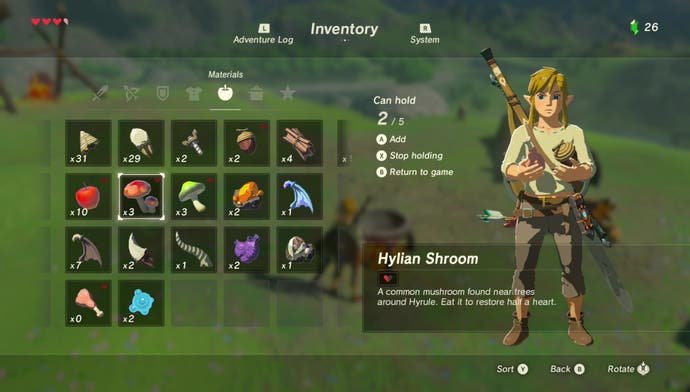Zelda: Breath of the Wild walkthrough - Guide and tips for completing the main quests
Our complete walkthrough to the massive Nintendo Switch and Wii U adventure.
Zelda: Breath of the Wild is the Wii U's swansong and the Switch's key launch game, making it Nintendo's most important game in years. It's also rather different, with a more open and free roaming structure and far less handholding, but still tons of side-activities and hidden things to find.
Our Zelda: Breath of the Wild walkthrough will soon provide a complete step-by-step guide to completing the main quest as well as the many things you can do on the side.
This Zelda: Breath of the Wild guide page, meanwhile, provides various tips and tricks to surviving the game's huge expansive world, from cooking to combat and upgrading Link's arsenal and abilities.
Zelda: Breath of the Wild walkthrough
Zelda: Breath of the Wild's structure is a little different to most Zelda games. There's no lengthy tutorial, and within minutes you're off exploring, raiding camps and foraging for ingredients.
There is a starting area - the Great Plateau - and from there, you're free to explore the wider world and tackle the game's main objectives as you see fit - or ignore them entirely.
Don't expect traditional dungeons with keys and locked doors or hidden Heart Containers either, instead tasking you with visiting key areas and completing dozens of Shrines - which you get a taste of early in the game - for new Spirit Orbs to trade for permanent upgrades and other abilities.
Great Plateau
- Zelda: Breath of the Wild - Great Plateau starting area, Follow the Shiekah Slate
- Zelda: Breath of the Wild - Oman Au Shrine and Magnesis Trial solution
- Zelda: Breath of the Wild - Keh Nanut Shrine, Cryonis Trial, River of the Dead
- Zelda: Breath of the Wild - Ja Baij Shrine location and Bomb Trial solution
- Zelda: Breath of the Wild - Owa Daim Shrine and Statis Trial solution
- Zelda: Breath of the Wild - Completing The Isolated Plateau quest, The Temple of Time
Dueling Peaks and Hateno
- Zelda: Breath of the Wild - Seek Out Impa, how to get to Kakariko Village
- Zelda: Breath of the Wild - Locked Mementos, how to get to Hateno Village
- Zelda: Breath of the Wild - Captured Memories locations for every Captured Memory
Water Devine Beast Vah Ruta and Zora's Domain
- Zelda: Breath of the Wild - Reach Zora's Domain from Inogo Bridge
- Zelda: Breath of the Wild - Facing a Lynel, get shock arrows by visiting Ploymus Mountain
- Zelda: Breath of the Wild - Vah Ruta dungeon, terminal locations
- Zelda: Breath of the Wild - Waterblight Ganon boss fight strategy
Fire Devine Beast Vah Rudiana and Death Mountain
- Zelda: Breath of the Wild - Death Mountain and Goron City, how to get fire resistance
- Zelda: Breath of the Wild - Abandoned North Mine, use cannons to rescue Yubono
- Zelda: Breath of the Wild - How to avoid sentries and get to each marker before boarding
- Zelda: Breath of the Wild - Vah Rudiana dungeon, all terminal solutions explained
- Zelda: Breath of the Wild - Fireblight Ganon boss fight strategy
Flying Devine Beast Vah Medoh and Rito Village
- Zelda: Breath of the Wild - Rito Village, find Teba at the Flight Range
- Zelda: Breath of the Wild - Vah Medoh dungeon, all terminal solutions
- Zelda: Breath of the Wild - Windblight Ganon boss fight strategy
Desert Devine Beast Vah Naboris and Gerudo Town
- Zelda: Breath of the Wild - Gerudo Town, Forbidden City Entry, getting heat resistance
- Zelda: Breath of the Wild - Yiga Valley Hideout in Karusa Valley, Master Kohga
- Zelda: Breath of the Wild - Vah Naboris dungeon, all terminal solutions
- Zelda: Breath of the Wild - Thunderblight Ganon boss fight strategy
Final preparations:
- Zelda: Breath of the Wild - Lost Woods route directions to reach Korok Forest
- Zelda: Breath of the Wild - Master Sword location and how to complete The Hero's Sword
- Zelda: Breath of the Wild - Destroy Ganon, how to beat final boss Calamity Ganon

More Zelda: Breath of the Wild guides
Like any open world worth its salt, there's much more to see and do beyond the main story...
Completion and upgrades:
- Zelda: Breath of the Wild - Shrine locations, Shrine maps
- Zelda: Breath of the Wild - Captured Memories locations for every Recovered Memory
- Zelda: Breath of the Wild - Great Fairy Fountain locations and how to upgrade armour
- Zelda: Breath of the Wild - How to get easy Rupees, quick Rupee farming spots
- Zelda: Breath of the Wild - Hylian Shield location for the best shield in the game
- Zelda: Breath of the Wild best armour - Ancient Armour from Robbies Research
Survival and exploration:
- Zelda: Breath of the Wild - Cooking explained, ingredients list and bonus effects
- Zelda: Breath of the Wild - Cold resistance with Warm Doublet, Spicy Pepper
- Zelda: Breath of the Wild - Fire resistance before reaching Death Mountain
- Zelda: Breath of the Wild - Heat resistance before reaching Gerudo Town
- Zelda: Breath of the Wild - Tame horses, how to use stables and get Epona
- Zelda Labyrinth solutions: South Loemi, North Lomei and Loemi Labyrinth Island
Enemies and monsters:
- Zelda: Breath of the Wild Guardians - How to get easy Ancient materials
- Zelda: Breath of the Wild - How to beat Stone Talus for easy Ruby, Flint, Amber and Opal
- Zelda Dragon locations and farming: Where to find Farosh, Dinrall and Naydra
- Zelda: Breath of the Wild Test of Strength locations and tips
DLC:
- Zelda: Breath of the Wild DLC 1 guide: The Master Trials explained, gear locations
- Zelda DLC 1 Treasure locations - Tingle, Majora's Mask, Phantom, Midna outfit locations
- Zelda DLC 1 - Travel Medallion location and the EX Teleportation Rumors quest explained
- Zelda DLC 1 - Korok Mask location and the EX Strange Mask Rumours quest explained
- Zelda Breath of the Wild DLC 2 guide: EX Champions' Ballad, Divine Beast Tamer's Trial
- Zelda - Master Cycle Zero best fuel explained and how to summon the Zelda bike
- Zelda - EX Treasure: Merchant Hood, Garb Of The Winds, Usurper King, Dark Armor
- Zelda - EX Royal Guard Rumors
- Zelda - EX Ancient Horse Rumors
- Zelda Breath of the Wild Xenoblade Chronicles quest

Zelda: Breath of the Wild tips to tackling open-world Hyrule
Learn the nuances of combat and exploration
Breath of the Wild takes inspiration from other more open adventures - whether it's Skyrim, Witcher 3, Far Cry or Monster Hunter - than previous Zelda games, and as such, there's a lots to learn and master.
Combat tips:
- Whenever possible use stealth in combat so you can get some free attacks in. Crouching immediately makes you harder to spot, while using cover and long grass will help you further. For low-level enemies, you can perform an instant-kill 'sneak strike' if you manage to stealth your way behind them without getting spotted.
- Aim for the head (or coloured weak points) to incur double the damage for an attack. Using the bow from afar while you haven't been spotted will make this so much easier.
- Jumping and falling will give you an edge in combat; pressing attack while dropping will see you slam your weapon into the ground, while drawing your bow will slow down time so you can aim with greater accuracy.
- Weapons will degrade and break regularly, so pick up as many spare clubs, bows and monster limbs (!) as you can so you always have something to fight with. The last hit when a weapon breaks will also deal bonus damage.
- While you can fight pretty much anything at any time, pick your battles. If you feel like your armour and weaponry isn't up to the task, retreat and come at it later. Or, use cooking to buff your stats temporarily.
- Clearing out Bokoblin camps will give you consumables, weapons and Rupees, but killing every enemy will unlock a nearby chest with a more valuable item. A useful one in Great Plateau starting area is Fire Arrows from the camp just east of the Temple of Time (the one with the giant skull).
- Enemies will 'level up' after you kill a certain amount of them, which you can prevent by avoiding combat altogether. However, some areas will always have weaker / stronger enemies, and by not levelling them up, you miss out on the more powerful loot they drop.
- You can consume food to restore health and swap weapons at any time in battle, as accessing menus pauses the game, meaning you don't have to retreat from a tight spot to get back into the fight.

Exploration tips:
- Inventory management is important, so be sure to cycle out things you definitely don't need or can't sell there and then. If you can't pick up something - whether from the ground or the chest - it'll remain until you leave the area.
- You can pass time by sitting at lit campfires until the following morning, noon or night. Certain enemies, plants and activities only happen at certain times of day, so use this to your advantage.
- Smash crates with heavier melee weapons for weapons and items. Avoid bombs, which send their contents flying.
- There is a stamina bar when you sprint, climb and swim, and when it depletes fully, expect to run out of air, fall to your doom or drown. When the bar goes red while climbing, jumping will give you one last massive boost, which you can use to your advantage to make it to your destination just in time.
- You can climb almost anything - whether it's trees for apples, buildings for vantage points or cliffs for new pastures - so don't feel like a steep incline is a barrier to exploring.
- With Zelda: Breath of the Wild being an open world game, climbing towers is the way you flesh out your map when visiting new areas. You'll see them from a fair distance away, but can also be easily obscured by mountains from other angles, so add them as custom waypoints to you map when you're close and activate them whenever you can.
Get your chef's hat on
Cooking is one of the key skills you need to learn in Zelda: Breath of the Wild. You'll find all kinds of ingredients as you explore, and while they can be consumed there and then for health, it's by cooking them that will increase their potency.
We've explained it in far greater depth over in our Breath of the Wild cooking and ingredients how-to, but to start cooking, find a pot over some food and set it ablaze with a torch and nearby fire, then get experimental. Some general rules the game teaches you are:
- Toss in anything edible and you'll make something Link can consume
- The more ingredients means more health recovery
- Mixing heartier ingredients like fish and meat with grains and vegetables is a good idea
- Spices and herbs help, while certain ingredients have certain effects, like health and stamina boosts, or warming you up
- Bugs and lizards can make elixirs and other unusual items, but aren't great for food

It's a useful skill to learn that extends the strength of your ingredients, and in some cases - such as early on when you need Cold Resistance - it can be almost essential. Collect everything you can and play around with what you have.
Use your Zelda amiibo to unlock bonus features and items
If you've been collecting Legend of Zelda amiibo over the past couple of years - whether it's those released as part of Super Smash Bros, Twilight Princess HD on Wii U, or the recent 20th anniversary and Breath of the Wild sets - then you'll have access to a number of bonus features and items.
The older Zelda amiibo will drop items from the sky, including barrels, fish and ingredients, while the Breath of the Wild amiibo set will offer early access to powerful in game items.
Finally, the Smash Bros Link will give you Epona, and scanning Wolf Link will add the Twilight Princess character as a companion, both of which you can watch in the above video.











